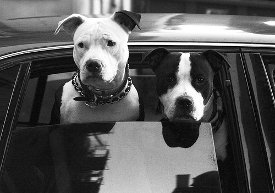
If you’re anything like me, you take the absolute best care of your pet. Making sure you only get them the highest quality pet food, best pet insurance, safe toys and plenty of veterinary checkups to ensure they stay in the best health. So you also know that moving with a pet can be tricky, as you’re essentially moving them from somewhere they feel comfortable to a new world of unfamiliarity.
There are few things more anxiety inducing for a dog or cat than watching pre-move preparation. Pets seem to have an innate fear of abandonment and abhor any changes to their routine. Dogs often deal with this anxiety with increasing neuroticism, chewing through couch legs and fixing their owners with permanently baleful eyes. Cats tend more towards the passive aggressive, situating themselves directly on top of their owners’ suitcases because you can’t leave if you can’t pack.
But it doesn’t have to be that way. Here are our tips for easing moving anxiety for everybody involved.
Before You Move
• Get the scoop on the new regulations. Contact your destination state’s Department of Animal Husbandry, as well as a new vet and any relevant housing authorities to learn about regulations that might differ from your home state, from leash laws to required vaccinations.
• Talk to your vet. Make sure your dog or cat is up to date on shots and ask for a health certificate that proves it.
• Identification. Make sure all pets, particularly house cats that may not have previously needed it, are clearly tagged with their name and your contact information. This is especially important in case your pet somehow gets out during the moving process or lost in your new community.
• Get a good carrier. Make sure it’s roomy enough to allow your dog or cat to stretch, that you’ve added in any favorite toys, and that’s it’s well-ventilated. Bring along comforting smells from home by lining the case with your pet’s bed or blanket, and practice driving your pet around in their carrier before the big day so he or she will have some sense of what’s coming.
• Determine your mode of transport. Will your pet be riding in the car with you, or will you using a pet mover? Do your research ahead of time so there are no surprises.
• Maintain your pet’s routine. Keeping things as normal as possible will significantly reduce your pet’s stress.
The Big Day
• Talk to your pet. If you had a toddler, what would you tell him or her about your upcoming move? Many dogs and cats have the intelligence of a three-year old. Keep them reassured and updated.
• Seclude your pet from chaos during the move. Keep your pet in a room with his or her favorite toys so they won’t be under foot or have a chance to escape.
• For very anxious pets, consider a sedative. Ask your vet for one that’s gentle on stomachs.
• Bring your pet pack. Make sure you’ve got everything you need – water, food, medicine, paper towels and sponges (in case of accidents), toys and leashes.
• Make it fun. Stop at rest stops frequently to let your pet play and stretch their legs. It is important though when somewhere unfamiliar to keep your pet on a leash to ensure they do not nervously run away.
After You Arrive
• Give your pet a tour of the new digs. Let them smell around the inside and outside of your house and give them a nice long walk in the new neighborhood. Make sure to keep them leashed so they don’t get lost if they become disoriented.
• Socialize your pet with new pets in the neighborhood. Check out the local dog park and make some new friends. Remember to be slow and steady on the introductions though.
• Choose a room in the house that can be just for your pet. Fill it with familiar, homey items.
• Find a new vet, groomer and kennel.
• Be prepared for your pet to punish you. This is true for all pets, but especially for cats, which attach more to their home. Get ready to receive the cold shoulder for a couple of days.
Moving houses is never easy on a pet, but the more time you take to consider your dog or cat’s needs, the sooner you can get down to the business of enjoying your new home. Make sure you ensure your pet’s health is in top shape before the move, consider dog insurance, and monitor your pet’s mood after the move is complete to ensure they are confident that you will be there for them during this major adjustment.
-Thanks to Rob Toledo for this article.
Was this useful to you? Get more useful, practical tips for enjoying life with dogs by subscribing to our weekly updates. It takes just a moment - simply enter your name and email in the green box at top right.
If you liked this, you may also like:
Dog Car Travel And The 2400-Pound Missile
How To Find A Lost Dog
Fabric Dog Crate
Photo credit: Nestor Lacle
|